

Vol. 40 (Number 01) Year 2019. Page 10
OSTROUSHKO, Alexander 1; KARPUHIN, Dmitry 2; MERKUSHOVA, Olesya 3; VOROBYOVA, Yulia 4; PONOMAREVA, Marina 5; STOLYAROVA, Alla 6
Received: 20/07/2018 • Approved: 03/11/2018 • Published 14/01/2019
ABSTRACT: The article analyzes the state of the information space of the Russian Federation from the viewpoint of ensuring the protection of children from the spread of harmful information that adversely affects their psyche. The role of law, parents and public institutions is comprehensively examined in order to minimize the potential threats of the influence of telecommunication networks on children's psyche. The analysis of the danger of spreading negative information on the Internet is carried out, to develop effective legal and social measures to counter the harmful effects on the psyche of minors. In order to minimize information threats when using the Internet by adolescents, recommendations for improving the legislation and the activities of public institutions are developed. |
RESUMEN: El artículo analiza el estado del espacio de información de la Federación de Rusia desde el punto de vista de garantizar la protección de los niños contra la difusión de información perjudicial que afecta negativamente a su psique. El papel de la ley, los padres y las instituciones públicas se examina exhaustivamente con el fin de minimizar las posibles amenazas de la influencia de las redes de telecomunicaciones en la psique de los niños. El análisis del peligro de difundir información negativa en Internet se lleva a cabo para desarrollar medidas legales y sociales efectivas para contrarrestar los efectos nocivos en la psique de los menores. Con el fin de minimizar las amenazas a la información cuando los adolescentes utilizan Internet, se desarrollan recomendaciones para mejorar la legislación y las actividades de las instituciones públicas. |
The modern period of the development of society is characterized by the rapid improvement of information technologies and the formation of a new information space. However, new telecommunication technologies have many hidden dangers. As a consequence, new types of unlawful acts appear. In 2016, Russia faced criminal manifestations in the Internet space, which public institutions and law enforcement agencies were not ready to counter. This is the promotion of suicidal behavior and calls for suicide, distributed both through the Internet and by sending SMS and newsletters through the use of various messengers, such as WhatsApp, Viber, Telegram and the like. A serious problem was that, due to the absence of formally fixed grounds for liability in the legislation, even if the organizers of the dissemination of such information were found, it was impossible to punish them. At present, the Russian state urgently solves the problem of minimizing any harmful effects on adolescents. We can state that the legislative measures adopted in recent years have reached their goal, and the society has realized the danger of impact on the child's psyche via telecommunications networks.
Diagram № 1
Respondents' assessment of the impact
of the Internet on the child's psyche
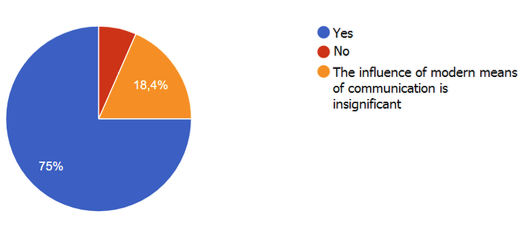
In addition, it was revealed that there were forces that began to influence the public consciousness. Their goal is to form an opinion that the impact on the psyche of children through communication networks is a well-planned hoax of the Russian authorities. After the publication of the book "Children in the Network," a group of researchers-folklorists accused the journalist of betraying "urban horrors" for the truth. Even in Wikipedia, the game "Blue Whale" (known and other names) is served as a Russian urban legend: "The news of the game’s that drove adolescents to suicide existence was widely massacred by the media and caused moral panic among the population of Russia. At the same time, the very fact of the game’s with the characteristic rules and attributes existence has not been confirmed so far…". Experts saw a connection between the launch of "death groups" and the legislative initiatives of Russia to tighten control over the Internet (KHUDENKO, 2018).
The statistical survey conducted by the authors of this article revealed: the overwhelming majority of respondents agree that modern means of communication represent a real danger to the child's psyche. In addition, respondents do not trust official data on the quantitative and qualitative scale of this impact. The level of confidence is shown in diagram 2.
Diagram № 2
The level of trust in official information about the
harmful effects on children through the Internet
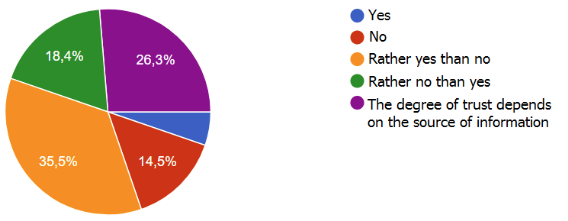
The problem of psychological impact on children through telecommunications networks received a wide response in the Russian media, however, few scientists subjected it to scientific analysis. The influence of informal Internet communities on the increasing number of adolescents’ suicides was studied mainly by representatives of psychological science, while the legal assessment of Internet resources often remained outside the scope of study. The most known article among the Russian legal studies is the one written by N. Krylova, who examined the criminal law aspects of combating "death groups" on the Internet (KRYLOVA, 2016). The work of O. S. Antyufeeva is devoted to criminological aspects of the spread of destructive content on the Internet and the impact of such information on minors (ANTYUFEEVA, 2015). In the world scientific community the phenomena of "cyberstalking" and "cyberbullying" are mainly studied as the main methods of psychological influence on minors in communication networks. There are disputes about what legislation should adequately suppress such acts (GEACH et al, 2009; GOODNO, 2007). Scientists have conducted studies to determine the prevalence, victimization of this phenomenon, studied the characteristics of victims and offenders, as well as the impact of cyber-persecution on the welfare and mental health of victims (DREßING at al, 2014). Many experts believe that cyberbullying is possible only among children and adolescents, therefore, special attention should be paid to the development of protective mechanisms to protect the child from bullying (BRIAN and GREGORY, 2002), however, it is not within the competence of the law. Since the solution of the problem of Internet bullying of children is given to educators and psychologists, the main attention is paid to the development of the theory of everyday activities in cyberspace (REYNS at al, 2011). The problem of increasing the number of suicides initiated over the Internet is known to scientists around the world and even got its own term for cybersuicide, the forms of manifestation of this negative phenomenon have been studied (STARCEVIC and ABOUJAOUDE, 2015)]. However, the issues of legal counteraction to cyber-suicide are poorly studied.
This justifies the need for this study, which is aimed at counteracting technogenic, sociocultural threats, terrorism and ideological extremism, as well as cyber threats and other sources of danger to society, economy and the state. The authors of the article put forward a hypothesis that it is necessary to design legal norms, that are aimed at protecting the information security of minors, more qualitatively, and to correlate the measures of legal influence with the measures of parental control and improvement of the process of school education.
38.2% of respondents supported the permissibility of expanding the powers of state bodies in the field of regulation of protection of minors from harmful effects on the psyche in information and telecommunications networks. 40.8% of respondents came to the conclusion that it is necessary to find a balance in the combination of state influence and public control in order to prevent the usurpation of the information space by the authorities.
Diagram № 3
Respondents ' assessment of the need for state regulation of the Internet
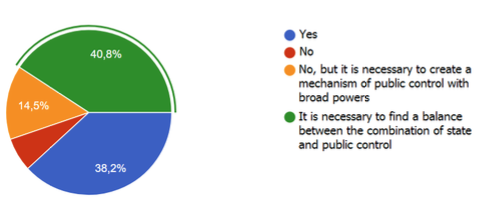
The research conducted by the authors is based on the results of the analysis of legal acts, scientific works in the field of law, sociology and education. A statistical processing of a significant amount of data, that characterizes the degree of influence on the children of harmful information distributed via the Internet, was carried out. To analyze the role of the Internet in public life and to identify negative factors of influence on the psyche of children, a sociological study was conducted among citizens through a survey of Russian citizens of different age groups.
During the survey on the special program we interviewed 179 respondents. In the age group 18-20 years is 19.7%, 21-30 years of 35.5%, 31-40 years is 28.9% and older than 40 years is 15.9%. Among the various professions of respondents, it can be noted that 56.6% are lawyers and 9.2% are educators. Interviewed respondents widely use information technology in their daily lives. According to them, the Internet is a special information space that has a positive impact on society.
Diagram № 4
The Internet from the respondents’ point of view
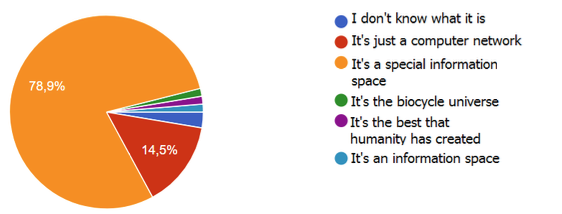
-----
Diagram № 5
The respondents’ attitude to the Internet
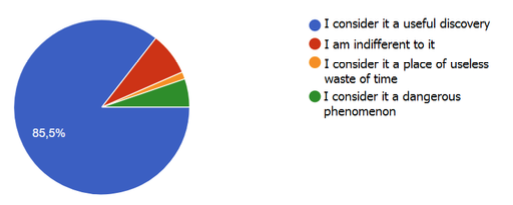
At the same time, the level of trust in the network is such that only 5.3% of respondents believe that the Internet is a dangerous phenomenon. The amount of time spent by the respondents in the Internet is shown in diagram 6.
The diagram №6. Using the Internet in everyday life.
To achieve representative of the research, a repeatedly tested framework model for assessing the potential negative effects of telecommunications networks on the mentality of underage children was used, based on responses to the questionnaire (AL-TALHI and AL-GHAMDI, 2014). The obtained results allow assessing the adequacy of the state's response to the needs of society in protection from a particular threat.
It is proved that previously negative psychological factors came directly from the real life of the adolescent and from the people around him, and today the Internet has become a huge influence on the adolescent, but today the Internet has become a huge influence on the adolescent. After all, in cyberspace, an adolescent can also act independently, make decisions, but at the same time not be responsible for the consequences. According to psychologists - researchers of the Internet space, the construction of a virtual personality (the English-language analogue of this concept - virtual identity) is the most typical strategy for the child's self-representation in the network (PEKARNIKOVA, 2014). He abstracts from the outside world, that is, from the problems of his associates, feels freedom and impunity, and many parents are glad that they do not have to communicate and pay much attention to their child (UGOLKOV, 2012).
The analysis of numerous publications on the Internet shows that the danger of this kind of new offense for Russia is the impact on minors through a calibrated psycho-emotional tactics (VASILIEV, 2009). For example, it is believed that the organizers of Internet appeals for suicide have a system based on the data of psychological science to introduce the child into a state of rejection from the world, from the family and further bringing him to suicide.
Decree of the President of the Russian Federation from 01.06.2012 № 761 "On the National Strategy of Action for Children in 2012 - 2017" set the task to develop a system of measures to protect minors from any negative mental impact. During the survey, we tried to find out what measures Russian citizens consider the most effective to prevent the impact on minors via the Internet. The survey showed that respondents in 88.7% of cases believe that the most effective means of counteracting mental abuse through the Internet is the introduction of strict liability for these acts. In addition to this, 73.2% advocate the improvement of educational policy, which is aimed at protecting childhood.
An important measure of countering this negative impact on the child's psyche should be the activation of parental control over the virtual life of their children. This allows you to detect the presence and prevent the spread of malicious information at the initial stage through parental intervention (PUT, 2017).
Law also has a very important role in countering the negative impact on children on the Internet. Changing the point of view on the nature and danger of these actions in the network in the long term will allow using the maximum resources for establishing all those involved in such actions: both organizers and executors, so-called curators, to identify producers, organizers and accomplices in the distribution of harmful content whose actions may be classified as a crime (BASTRYKIN, 2017).
Our sociological survey showed that the overwhelming majority of respondents believe that it is necessary to combat harmful information by introducing new criminal penalties. The respondents underestimated the norms of other industries in the issue of countering this phenomenon. These circumstances increase the risks of negative consequences at the initial stage of negative information impact. Thus, it can be concluded that in public opinion priority is given to prohibitions and punishment, and not to the material regulation of relations. Respondents completely underestimated the possibility of control by parents, the school and the public in countering these negative phenomena (this is reflected in diagrams No. 7 and No. 8).
The diagram №7. Evaluation of the possibility of counteracting the information impact on children through the Internet through parental control.
The diagram №8. Evaluation of the possibility of counteracting the information impact on children through the "Internet" network through the activities of educators and the public.
In order to counter the threat to the lives of minors, which comes from various networked associations, it was necessary to further develop and adopt a number of legislative acts in Russia. First of all, it was a block of laws aimed at countering the committing of suicide or facilitating the committing of suicide.
Article 15.1 of Federal Law No. 149-FZ of July 27, 2006 "On Information, Information Technologies and Information Protection" (hereinafter referred to as the "Information Act ...") was supplemented with Clause 14. It establishes the following: in case of revealing information on the Internet about еру methods of committing suicide, as well as appeals for committing suicide, the executive body, which exercises control and supervision functions in the sphere of mass media and mass communications, is obliged within 24 hours to inform about the identified violations of internal affairs bodies, so that they take adequate measures to neutralize the identified threats.
In addition, changes in the part of building a system for the prevention of cases of negative impact on minors via the Internet have affected Federal Law No. 120-FZ of June 24, 1999 "On the Basics of the System for the Prevention of Neglect and Juvenile Delinquency."
In the "Information Act ..." from 01/01/2018, WhatsApp, Viber and others are legally defined as an information and communication instant messaging service.
The law provides for the operator to limit access to the electronic messaging service based on the decision of the authorized authority or the court decision. The adoption of this law has placed a reliable barrier to the spread of malicious content in this medium of information transmission.
In addition, the changes will allow to combat the mass mailing of unsolicited messages (Spam), since the user of the service is legally authorized to refuse to receive electronic messages from other users.
Further improvement of the legislation of the Russian Federation follows the path of legislative regulation of the use of information technologies for the purposes of identification of citizens of the Russian Federation. The relevant changes have already been made to the legislation and this will allow the identification of a citizen without personal presence through the Internet when communicating with state bodies, banks and other organizations.
We believe that the issue of dissemination and adaptation of these procedures for the identification of users when working in social networks and other Internet resources requires a comprehensive and detailed study. Our risk analysis does not allow us to conclude that it is necessary to maintain mandatory identification of all customers when working on the Internet. However, parents interviewed by us, as well as children's educators and psychologists, expressed their wishes about the need for such identification in resources directly targeting minors.
We fully support the point of view of L.V. Tereshchenko. He believes that Russian law lags far behind the development of relations arising in connection with the use of the Internet, does not know the terms used in relation to these relations. In addition, a number of obviously unlawful acts cannot be correlated (or to make it unambiguously difficult) with the criminal offenses established by the Criminal Code of the Russian Federation (TERESCHENKO and STARODUBOVA, 2017).
It is necessary to pay special attention to the development of the theory of daily activities in information and telecommunications networks for all its participants.
The need for an early development of a state program to provide methodological materials for the educational process and parents for the purposes of teaching children information, including online security, was confirmed by the respondents (Diagram № 9).
The diagram №9. Assessment of the need to develop methodological materials for parents in order to counteract harmful effects on the Internet.
In addition, in the process of teaching a child, he needs to help build the competencies that will allow him to be on the Internet safely. We believe that very little is being done for this at the moment. In Russian schools, the lesson of safety behavior in the Internet is held only once a year. Order of the Ministry of Education and Science of Russia from 17.12.2010 N 1897 "On the approval of the federal state educational standard of basic general education" does not contain a requirement for the formation of minors' competence in safe behavior in the information environment.
As can be seen from the above, the state adopts legal acts aimed at countering suicidal threats in the Internet space. At the same time, the General vector of countering these threats is aimed at ascertaining the types of harmful information that poses a potential danger to children, as well as at strengthening the repressive component for the dissemination of this information (the establishment of appropriate criminal penalties).
However, at present, there is an imbalance between punitive measures and social impact. In our opinion, the instruments of social influence should be public institutions, in particular, the family and the school. Currently, the Russian system of secondary education is practically not adapted to counter the coming from the Internet threats against children. In particular, point 7 of the Decree of the President of the Russian Federation of 01.06.2012 N 761 only partially affects the problem of counteraction to Internet threats from public institutions. For example, paragraph 7 of the Decree States the need to establish public mechanisms for the examination of Internet content for children. In addition, the Decree notes the need to create portals and sites that accumulate information about the best resources for children and parents, and to encourage parents to use the service "Parental control", which allows you to set restrictions on access to the Internet.
The situation shifted from the dead-end in 2017, when the Ministry of Education and Science of the Russian Federation issued Letter No. VK-1065/07 of March 31, 2017 "On the direction of methodological materials." The situation has moved from a dead point in 2017, when the Ministry of education and science of the Russian Federation issued a Letter dated March 31, 2017 N VK-1065/07 "on the direction of teaching materials". These recommendations prescribe the prevention of negative behavior of students in connection with the negative impact of the Internet. As the main preventive tools for countering threats, confidential communication and control over the use of the Internet are indicated.
It should be noted that these recommendations provide for counteracting threats to children in two directions to parental and school control:
1. The use of parental control tools through the organization of parents' meetings in order to conduct explanatory work on potential threats that originate from the Internet. Parents should be familiarized with information on emergency services that can be contacted in case of emergency, as well as Internet resources, as well as online resources that represent potential threats to adolescents.
2. The use of educational measures against minors to prevent threats coming from the Internet. A key role here is assigned directly to the educator, who is endowed with a certain pedagogical authority. This set of measures involves the creation of a favorable moral and ethical climate in the classroom; carrying out of explanatory work with adolescents about various Internet risks; the creation of groups of constructive orientation, counteracting destructive internet communities; special trainings aimed at developing skills to overcome difficult situations; informing adolescents about ways to get help in difficult situations, about specialists who can provide such assistance; identification of children with signs of distress in the emotional, behavioral, social spheres; support contact with schoolchildren’ parents.
In addition to strictly preventive measures, the recommendations provide for specific measures of pedagogical influence in case of a threat of psychological instability and / or the life of a adolescent associated with the dissemination of negative information on the Internet.
These measures include:
1) Checking the information received by the educator through a meeting with an adolescent, clarifying intentions, providing such an adolescent with support in overcoming crisis experiences. The educator must notify the administration of the educational organization, which should contact the division of the Commission on Minors Affairs for joint development of options.
2. A heart-to-heart talk is recommended as a mean of reducing the risk of negative information’s impact. It is designed to reduce the adolescent’s destructive need in antisocial behavior.
The life of minors (in particular, their socialization) in the modern world is directly related to the Internet and other means of communication. This requires building a well-thought-out set of organizational and legal measures, coordinated actions of law enforcement agencies, educators, providers, parents, all members of the society. Given the development of the information space, its expansion and the lack of clearly defined boundaries, there are attackers who, using the means of social engineering, spread on the Internet harmful information that negatively affects children. According to the authors, Russia has created a system of combating such acts, law enforcement has a real tool to block these resources in the network and bring the perpetrators to justice. However, the analysis of the legislation aimed at counteracting the negative impact on the Internet shows that repressive measures (which are expressed in the appointment of criminal penalties for inducing and disseminating harmful information that has a negative impact on children) are far ahead of the measures of parental and school control that are indicators of the development of civil society. Only a reasonable combination of measures of state coercion with measures of social impact will solve the problem of spreading threats on the Internet, encroaching on the life and health of minors. In addition, the proposed recommendations consider the educator as a key element in counteracting the spread of harmful information in the school environment. In our opinion, this problem should first of all be dealt with by school psychologists with special powers in the field of combating suicidal tendencies of adolescents. A positive example in this respect is the example of Israel, where school psychologists are given the right to "control over parental control", which is expressed in taking action against parents who do not restrict children's access to the Internet.
In our opinion, the recommendation to create constructive groups that oppose destructive Internet communities should not be confined to the framework of an educational institution. The generation of these public institutions can also take place at the level of public associations and organizations that oppose the dissemination of harmful information on the Internet.
ALFONSO Tovilla-Zarate, Carlos; POOL Garcia, Sherezada; JUAREZ-ROJOP, Isela E.; et al. (2017). Necessity of Internet regulation to prevent suicides in Mexico. International journal of social psychiatry, Vol: 63, issue: 4, pp.: 376-377.
AL-TALHI, A.H., AL-GHAMDI, A.A. (2014). IT governance: Performance and risk management evaluation in higher education. Information (Japan), Volume 17, Issue 12B, Pages 6355-6369
ANTYUFEEVA, O.S. Questions of prevention of suicides among minors in the information society (2015). Actual questions of law and branch sciences, No. 1 (1). Pp. 32-36.
BASTRYKIN, A.I. (2017). Online crimes against minors: to the issue of victimological prevention and criminal law assessment. Russian Journal of Criminology, vol. 11, No. 1, pp. 5–12.
BRIAN, H. Spitzberg, GREGORY, Hoobler (2002). Cyberstalking and the technologies of interpersonal terrorism. New Media & Society. Volume: 4 issue: 1, page(s): 71-92.
DREßING, H., BAILER, J., ANDERS, A., WAGNER, H. and GALLAS C. (2014). Cyberstalking in a Large Sample of Social Network Users: Prevalence, Characteristics, and Impact Upon Victims. Cyberpsychology, Behavior, and Social Networking, Volume: 17 Issue 2. pp. 61-67.
GEACH, N., HARALAMBOUS, N. (2009). Regulating Harassment: Is the law fit for the social networking age?, Journal of Criminal Law. P. 241 - 257;
GOODNO, N.H. (2007). Cyberstalking, a new crime: Evaluating the effectiveness of current state and federal laws. Missouri Law Review. P. 125 - 197.
JEE, Y.-J. (2015). Influencing factors on youth drug use; using the 2014 youth risk behavior web-based survey. Information (Japan), Volume 18, Issue 5, Pages 2149-2156.
KHUDENKO, K. (2018). Where did the "blue whale" sail away?. DELFI, June 11.
KRYLOVA, N.E. (2016). "Death Groups" and teenage suicide: criminal law aspects. Criminal law, № 4. P. 36 - 48.
PEKARNIKOVA, M.M. (2014). Generation of an individual virtual space: the psychological aspect. Philosophy and the humanities in the information society, No. 1. P. 95-104.
PUT, B. (2017). Materials of the meeting of the working group in the Public Chamber of the Russian Federation on counteracting the propaganda of suicides. URL : https: //www.oprf.ru/press/news/2017/newsitem/40980
REYNS, W., HENSON, B., BONNIE, S. (2011). Fisher Being Pursued Online Applying Cyberlifestyle–Routine Activities Theory to Cyberstalking Victimization. Criminal Justice and Behavior. Volume: 38 issue: 11, page(s): 1149-1169.
SCHNITTMAN, J. (2016). Israeli law: Social services and family rights. URL: http://pravo.israelinfo.co.il/articles/sem
STARCEVIC, V. and ABOUJAOUDE, E. (2015). Cyberchondria, cyberbullying, cybersuicide, cybersex: “new” psychopathologies for the 21st century?. World Psychiatry, 2015.14: 97–100.
TERESCHENKO, L.K., STARODUBOVA, O.E. (2017). Mysteries of the Information Law. Journal of Russian Law, No 7. P. 156-161.
UGOLKOV, N.V. (2012). The Influence of the Internet on the Socialization of Senior Students. Historical and Socio-Educational Thought, No. 4, P. 173-174
VASILIEV, V.L. (2009). Legal psychology. St. Petersburg, 608 p.
1. Department of Legal Regulation of Economic Activites, Financial University under the Government of the Russian Federation, 125993, Leningradsky Prospekt 49, Moscow, Russia. E-mail: ostroushko@mail.ru
2. Department of Legal Regulation of Economic Activites, Financial University under the Government of the Russian Federation, 125993, Leningradsky Prospekt 49, Moscow, Russia
3. Institute of International Law and Economics, 111024, highway Enthusiasts, 21, Moscow, Russia.
4. Department of Legal Regulation of Economic Activites, Financial University under the Government of the Russian Federation, 125993, Leningradsky Prospekt 49, Moscow, Russia
5. Department of «Economics of organization» Financial University under the Government of the Russian Federation, 125993, Leningradsky Prospekt 49, Moscow, Russia
6. Head of the Department of Commodity Research, State Social and Humanitarian University, 140410, Zelenaya st. 30, Kolomna, Russia